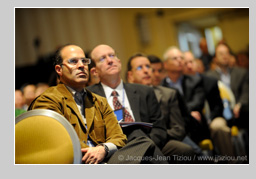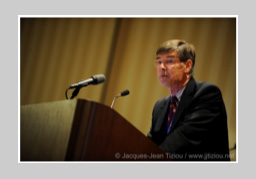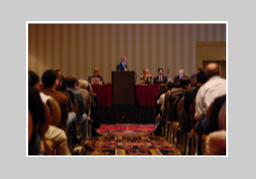Meeting Summary
Slideshow pictures provided by photographer JJ Tiziou.
To view the complete set of JJ's Rhinology World 2009 photos, or to purchase copies, please visit:
JJ Tiziou Photos
To view all of JJ's photos as an animated video, see:
Video
For additional photos of the conference and the Faculty Dinner by photographer Drew Saracco, click here. These photos may be printed or downloaded with our compliments.
MEETING SUMMARY HIGHLIGHTS
Thursday, April 16, 2009
Dr. David Kennedy welcomed attendees to the 2009 Rhinology World Conference, a compilation of the XIII International Rhinologic Society, the XXVIII International Symposium on Infection and Allergy of the Nose, the 2009 Spring Meeting of the American Rhinologic Society, and the Basic Course of the American Academy of Otolaryngic Allergy. Dr. Valerie Lund opened the meeting with her keynote address on a Contemporary Overview of Chronic Rhinosinusitis (CRS). Her talk set the tone for the following sessions as they delved into the pathogenesis of CRS. Conference, a compilation of the XIII International Rhinologic Society, the XXVIII International Symposium on Infection and Allergy of the Nose, the 2009 Spring Meeting of the American Rhinologic Society, and the Basic Course of the American Academy of Otolaryngic Allergy. Dr. Valerie Lund opened the meeting with her keynote address on a Contemporary Overview of Chronic Rhinosinusitis (CRS). Her talk set the tone for the following sessions as they delved into the pathogenesis of CRS.
In the Round Table session Dr. Claus Bachert discussed the role of superantigens in CRS such as the Staphylococcus aureus antigen and its implication in IgE synthesis and eosinophil influx, and its association with a Th2 response in nasal polyposis. Dr. Noam Cohen spoke about the importance of mucociliary clearance and presented new data that demonstrated Pseudomonas aeruginosa conditioned media inhibits not only mechanostimulation of beating cilia but also recruitment of "reserve" cilia. Dr. James Palmer discussed the role biofilms play in inflammation and presented recent findings that the presence of biofilms in CRS are associated with a unique inflammatory milieu including elevated levels of T helper cells, B cells, and neutrophils as well as cytokines and chemokines that suggest a Th1 and possibly Th17 skewing. Dr. David Kennedy, in a discussion of osteitis, presented evidence that neoosteogenesis is a significant occurrence in the disease process and there is a significantly higher amount of bone turnover in CRS vs. Control sinuses. Dr. Heinz Stammberger closed the session arguing that Allergic Fungal Sinusitis (AFS) is actually a misnomer as there is no evidence to show that IgE-allergies cause AFS. Discussion at this panel led to the consensus that CRS is a multi-factorial disease manifesting in several phenotypes, but that all arise from the disruption of mucociliary clearance resulting in mucostasis.
The following session, the Great Debate moderated by Dr. Alex Chiu, included a contrast and comparison of the different surgical strategies including Sinuplasty, MIST, FESS, Nasalization, and Balloon Dilation. Presentations were given by Dr. Jean-Michel Klossek, Dr. Bradley Marple, Dr. Reuben Setliff, Dr. Michael Setzen, and Dr. Frederick Kuhn.
In a mini seminar on Evidence Based Medicine in Rhinology, Dr. Richard Orlandi pointed out that most of the evidence supporting FESS is either retrospective or prospective but without comparison groups. Likewise, the support for image guidance in FESS is mostly level 4 uncontrolled studies as it is difficult and ethically unsupported to get randomized control groups. Dr. Wytske Fokkens, in a discussion of therapeutics, presented evidence that oral antibiotics (>12 weeks) are relevant in non-polypoid CRS but there is still no evidence to support its effectiveness in nasal polyposis. Evidence supporting topical steroids and saline irrigations are found in both disease states with the inclusion of oral steroids in the case of nasal polyps. Finally, Dr. Fenna Ebbens discussed the lack of evidence implicating specific species of fungi in rhinosinusitis.
In a mini seminar on Mucosal Innate Immunity and CRS, Dr. David Conley opened with an overview on the current understanding of innate immunity highlighting the resident dendritic cells and their role in T cell recruitment and ultimately Th1 or Th2 skewing. Dr. Andrew Lane presented new data on chitin and its possible role in Th2 skewing. Dr. Robert Schleimer demonstrated that anti-microbial genes such as the S100's as well as a protease inhibitor, SPINK5, are minimally expressed in CRS and their failure may contribute to the progression of disease.
In a mini seminar on Management Strategies for Chronic Rhinitis Dr. Eugenia Vining spoke about the importance of preserving the middle turbinate and presented several cases of rhinitis. Dr. Fabiana Valera presented evidence that in a comparison of different steroids, glucocorticoids are the best treatment for the majority of rhinitis symptoms. Dr. Christian von Buchwald talked about the use of FESS in CRS and presented several cases that do not fit the European Position Paper on Rhinosinusitis and Nasal Polyps. Dr. Yosef Krespi gave an additional talk about the use of light and laser therapy as potential treatment regimes in CRS including RhinoLight with its mixed visible and ultraviolet (UV) light technology, Bionase, which uses visible light to treat allergies, and a combination of methylene blue and red light therapy that has already been demonstrated to be successful at pre-operative prophylactic elimination of MRSA in carriers.
Friday, April 17, 2009
Dr. Heinz Stammberger delivered the keynote address on the second day of the conference with a discussion of the Evolution of Functional Endoscopic Sinus Surgery (FESS), emphasizing the role that videos had on being one of the driving forces in spreading the technique throughout the world. The following Round Table session provided a discussion of current surgical techniques. Dr. James Palmer, in his discussion of current powered instrumentation, presented the many different advantages of power from polyp to bony removal, but also gave words of caution of the catastrophic complications that can result in misuse. He also introduced the latest in power instrumentation, a hydrodebrider that would act as a pulse irrigator for the sinuses designed to help remove mucosal biofilms. Dr. Howard Levine talked about the use of balloons in sinuplasty, which was contrasted by Dr. Wytske Fokkens' discussion of radical procedures including Draf III techniques for frontal sinus surgery. Dr. Alex Chiu elaborated on extended frontal sinus procedures including the modified Lothrop, trephine, and osteoplastic flap as well as frontal sinus obliteration and unobliteration. Dr. David Kennedy discussed the changes in surgical approach since FESS first originated, stressing the key points of mucosal preservation and avoidance of bone exposure. Finally, Dr. Heinz Stammberger discussed changes in frontal sinus surgery. of the conference with a discussion of the Evolution of Functional Endoscopic Sinus Surgery (FESS), emphasizing the role that videos had on being one of the driving forces in spreading the technique throughout the world. The following Round Table session provided a discussion of current surgical techniques. Dr. James Palmer, in his discussion of current powered instrumentation, presented the many different advantages of power from polyp to bony removal, but also gave words of caution of the catastrophic complications that can result in misuse. He also introduced the latest in power instrumentation, a hydrodebrider that would act as a pulse irrigator for the sinuses designed to help remove mucosal biofilms. Dr. Howard Levine talked about the use of balloons in sinuplasty, which was contrasted by Dr. Wytske Fokkens' discussion of radical procedures including Draf III techniques for frontal sinus surgery. Dr. Alex Chiu elaborated on extended frontal sinus procedures including the modified Lothrop, trephine, and osteoplastic flap as well as frontal sinus obliteration and unobliteration. Dr. David Kennedy discussed the changes in surgical approach since FESS first originated, stressing the key points of mucosal preservation and avoidance of bone exposure. Finally, Dr. Heinz Stammberger discussed changes in frontal sinus surgery.
Dr. Bert O'Malley, Jr. moderated a debate about Open vs. Endoscopic Approaches for Malignancy. Dr. Ivo Janecka argued for the external approach while Dr. Piero Nicolai rebutted with the successful examples of various endoscopic approaches. Dr. O'Malley concluded the session with a presentation of a case of a patient with a radiation induced low-grade salivary gland tumor in the infratemporal fossa. Drs Janecka and Nicolai were able to argue their respective sides throughout Dr. O'Malley's management of the case.
In a lively debate about the Genetics vs. Environment role in CRS, Dr. Martin Desrosiers argued that susceptibility to the development of CRS is primarily genetically determined and provided data showing gene association with CRS patients compared to healthy controls. On the other hand Dr. Wytske Fokkens argued that the environment plays a major part in the development of CRS, stating that there is no evidence to support that CRS runs in families and also highlighted published data linking smoke and other pollutants to CRS. At the end of the debate a vote was cast by the audience and it was almost unanimously decided that it is a combination of both genetic predisposition and environmental stimulation that leads to a diseased state.
Dr. Niels Hoiby initiated the session on Mucosal Biofilms by talking about mucoid-producing Pseudomonas aeruginosa that are found in the sinuses of patients with Cystic Fibrosis (CF). Dr. Christian von Buchwald followed this with a more in-depth look at the genotypes of P. aeruginosa in the sinuses of CF patients and found that in 13 patients with Pseudomonas, all had different genotypes of the bacteria, which were sequentially found in the lungs, suggesting a more active role of Rhinologists may be indicated. Dr. Jeff Leid discussed the robustness of biofilm growth in the face of the immune system. Dr. Erica Thaler presented a novel device called the "Electronic Nose" which is capable of differentiating biofilm from non-biofilm forming bacteria and may be a potentially useful diagnostic tool in CRS. Finally, Dr. Alkis Psaltis discussed the clinical relevance of biofilms and presented a prospective study that implicated biofilms with worse endoscopic and radiographic findings as well as worse post-operative quality of life scoring.
In an Instructional Course on Topical Therapies, Dr. Richard Harvey presented information on various delivery devices such as the neti pot and squeeze bottles, which he determined were the most effective at irrigating the sinuses. Dr. Chris Brown discussed the impact of saline rinses in sinusitis and determined that isotonic saline is more often effective than hypertonic saline. Dr. Alex Chiu introduced a novel steroid eluting biodegradable stent that has been shown to be an effective anti-inflammatory topical agent in a rabbit model of bacteria-induced sinusitis. Dr. Larry Kalish discussed the lack of evidence that anti-fungals and anti-bacterial topical agents are safe and effective, however there is some evidence supporting the use of mupirocin in the sinuses. Finally, Dr. Noam Cohen presented data that suggests surfactants, such as J&J's baby shampoo, are effective at preventing bacterial biofilm formation and at the same time maintain the integrity of the mucosal cilia.
Saturday, April 18, 2009
The keynote speaker for the third day of the conference was Dr. Aldo Stamm whose discussion went Beyond the Paranasal Sinuses. This was followed by a Round Table discussion of surgical techniques and included presentations by Dr. Heinz Stammberger, Dr. Alexandre Felippu, Dr. Vijay Anand, Dr. Roy Casiano, Dr. Rodney Schlosser, and Dr. Piero Nicolai. Stamm whose discussion went Beyond the Paranasal Sinuses. This was followed by a Round Table discussion of surgical techniques and included presentations by Dr. Heinz Stammberger, Dr. Alexandre Felippu, Dr. Vijay Anand, Dr. Roy Casiano, Dr. Rodney Schlosser, and Dr. Piero Nicolai.
In a Great Debate about the role of Fungus vs. Bacteria in CRS, Dr. Jens Ponikau presented evidence that implicates fungi as being the predominant effecter of CRS due to its association with IL-5 and IL-13 as well as influx of eosinophils. He also supported this by demonstrating that anti-fungals and anti-IL-5 therapies are successful at treating CRS. Dr. Robert Kern argued that bacteria play a more important role in CRS due to evidence that the down-regulation of anti-microbial genes are associated with CRS patients and this allows bacteria to expand and flourish.
Dr. James Palmer opened the seminar on Skull Base Reconstruction with a presentation on laser tissue welding, a technique that uses a laser solder coagulum paired with energy from a copper diode laser to create a stable tissue-solder bond, for skull base repair. The laser weld creates an instant bond between the solder and tissue and has a burst pressure that exceeds human intracranial pressure with no residual thermal tissue injury. Dr. Balwant Gendeh discussed anterior cranial fossa fistula repair and gave examples such as the Bath Plug technique and in larger leaks involving the anterior and ventral skull base tumor, surgery of the nasal septal flap is preferred. Dr. Roy Casiano spoke about the impact of etiology on graft repair of skull base defects (leak localization). And Dr. Ricardo Carrau discussed the use of vascularized flaps for skull base repair and presented evidence that their use dramatically improves post-operative CSF leakage compared to no flap.
In a seminar on Frontal Sinus Fractures, Dr. Andrew Murr discussed possible approaches to frontal sinus injury including the midforehead approach, which can be disguised by forehead wrinkles, the bicoronal approach, a more cosmetically acceptable approach, and access directly through the laceration if one is present. Dr. Steven Pletcher talked about long-term complications of frontal sinus obliteration including mucocele formation and necrosis and the pros and cons of endoscopic vs. external approaches in revision surgery. And lastly, Dr. Jacob Steiger detailed the endoscopic approaches to frontal sinus fractures including endoscopic assisted frontal sinus trephine, endoscopic frontal sinusotomy with transnasal reduction, and endoscopic frontal sinusotomy for outflow tract obstruction.
In a seminar on Microbes in CRS, Dr. Neil Bhattacharrya presented evidence that pathogenic bacteria are more often seen in patients with CRS than in controls and acute exacerbation is often associated with a shift to these pathogenic bacteria. Dr. Jeff Leid discussed several molecular assays with greater sensitivity than standard laboratory culturing for identifying communities of bacteria and these techniques are finding several classes of bacteria that are associated more with CRS tissue than healthy controls. Dr. J.S. Lacroix discussed the efficacy of mupirocin treatment for Staphylococcus aureus carriage and presented evidence suggesting the presence of S. aureus in asymptomatic patients could be an indicator of poorer long-term outcome. And Dr. Robert Kern described how the down-regulation of certain anti-microbial mucosal genes leads to the proliferation of bacteria and stimulation of ineffective immune cascades.
In a mini seminar on Wound Healing and FESS Dr. Parul Goyal discussed the importance of cilia function and presented evidence that cilia from diseased mucosa has a lower basal ciliary beat frequency (CBF) and that a low CBF is also associated with disorganization of cilia. Also, cilia from diseased mucosa do not increase CBF by chemical or mechanical stimulants compared to control mucosa, implying a mucociliary defect in diseased mucosa. Dr. Richard Orlandi discussed perioperative considerations in optimizing wound healing and emphasized the importance of continuing maximum medical therapy through the surgical appointment and to be selective post-operatively when debriding the sinuses, removing only the larger scabs to prevent scaring. Finally, Dr. Rakesh Chandra discussed the enhancement of wound healing through biotechnology and discussed several experimental trials in animal models, such as the use of an autologous platelet gel, for promoting wound healing.
As reported by: Jennifer M. Kofonow, M.S
|













